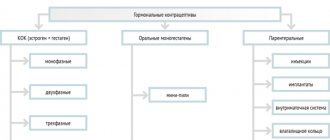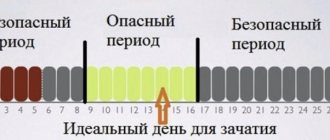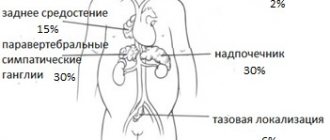Endometriosis is a disease in which tissue from the lining of the uterus is found in places where it normally should not be. Most often, endometrioid heterotopias affect the ovaries, fallopian tubes, bladder, and less often spread beyond the pelvis: to the intestines, kidneys, lungs, navel, brain, nerves, and postoperative scars.
According to statistics, endometriosis occurs in 3–10% of women of childbearing age. But these data may be underestimated, because often the disease is asymptomatic, and it can only be diagnosed after examination or accidentally during surgery for another reason.
For example, according to various studies, asymptomatic endometriosis is found in 1–7% of women during tubal ligation, in 12–32% during surgery for pelvic pain, and in 9–50% during surgery for infertility.
Most often, the disease is diagnosed in women aged 20–45 years. In girls before puberty, endometriosis practically does not occur.
Why does endometriosis occur?
The exact cause of the development of this pathology is currently unknown. Doctors and scientists have some theories:
- Retrograde menstruation. According to this theory, blood moves in the opposite direction during menstruation. Instead of leaving the uterus through the vagina, it enters the fallopian tubes, and through them into the pelvic cavity. The cells that are found in it attach to the surface of the organs and give rise to endometrioid heterotopias. All women experience retrograde menstruation to some degree, but not everyone develops endometriosis. It is believed that this is due to the peculiarities of the immune system.
- There may be genes that cause a predisposition, because a woman's risk of the disease is increased if it is diagnosed in her close relatives.
- Transformation of peritoneal cells. The peritoneum is a thin film that lines the inside of the abdominal wall and covers the internal organs. Perhaps hormones or immune factors cause the transformation of peritoneal cells, as a result of which they become similar to the cells of the uterine mucosa.
- Transformation of embryonic cells. This theory states that during puberty and reproductive age, embryonic cells are transformed into endometrioid heterotopias under the influence of hormones.
- Implantation of endometrial cells into the scar. During some surgical procedures, such as cesarean section, cells from the lining of the uterus enter the scar, attach to it and form growths.
- Lymphogenic and hematogenous route. Cells from the lining of the uterus migrate to various organs through lymphatic or blood vessels.
- Immune theory. It is believed that when the immune system is disrupted, it cannot recognize and destroy endometrial cells that are located in unusual places.
None of these theories provides a complete explanation of the causes of endometriosis or answers all questions related to this disease. Scientists continue to work in this direction.
Operating principle
Silhouette birth control pills have two main mechanisms of action:
- inhibition of ovulation;
- increasing the viscosity of cervical secretions, which prevents sperm from entering the uterus from the vagina.
Only one in a hundred women taking the drug for a year will become pregnant.
The specificity of Silhouette lies in its ability to reduce the level of male sex hormones androgens, which are also produced by women. This is how the antiandrogenic effect of the drug is realized:
- acne disappears;
- The severity of seborrhea (dandruff) is reduced.
One of the ingredients of the drug, dienogest, is a modern synthetic gestagen. Unlike many substances of this type, they do not have side effects such as weight gain or swelling.
Additional features of the drug Silhouette:
- long-term use reduces the likelihood of progression of atherosclerosis, increases the level of “good” cholesterol - high-density lipoproteins in the blood;
- The menstrual cycle is normalized, menstruation becomes less painful;
- The intensity and duration of menstruation are reduced, so the likelihood of iron deficiency anemia is reduced;
- the likelihood of uterine and ovarian cancer is reduced.
The main indication for use of Silhouette is contraception.
Symptoms
The main manifestations of endometriosis are pain in the lower abdomen, pelvic area and painful periods. Other possible symptoms:
- Pain during sexual intercourse.
- Painful urination.
- Heavy periods, bleeding in between.
- Pain during bowel movements.
- Problems conceiving a child, infertility.
- Diarrhea or constipation.
- Nausea.
- Bloating.
- Blood in the urine.
Many of these symptoms are cyclical, worsening before and during your period and then improving.
Contraindications
Under the following conditions, Silhouette OC should not be prescribed and its use should be discontinued immediately:
- signs of vascular disease;
- Chest pain when exerting;
- sudden severe shortness of breath or dizziness, episode of loss of consciousness;
- migraine;
- a month before surgery, after which there is little mobility and up to 2 weeks after complete recovery;
- diabetic angiopathy;
- increased blood pressure to 180/100 or more;
- bleeding disorders, high cholesterol, or liver and triglyceride test results;
- Any liver tumors, including pre-existing and benign tumors;
- suspected genital or breast cancer;
- Vaginal bleeding of unknown cause;
- Pregnancy, including possible pregnancy;
- lactation;
- intolerance to lactose, glucose, galactose.
Diagnostic methods
The main and most accurate method for diagnosing endometriosis is laparoscopy. During the examination, the doctor makes a puncture in the abdominal wall and inserts a laparoscope through it - a special instrument with a miniature video camera. Due to their characteristic appearance, the lesions are often described as “cigarette burns.” If necessary, during laparoscopy, a biopsy can be performed - fragments of pathologically altered tissue can be obtained and sent to the laboratory for examination under a microscope.
But the lesions may not always be on the surface of the organs. For example, some are cysts inside the ovaries. Ultrasound helps identify them. During surgery, a characteristic content is found in such a cyst, which looks like chocolate syrup.
Magnetic resonance imaging may be ordered before surgery. It will help clarify the size and location of lesions and plan surgical intervention.
Treatment of endometriosis
Endometriosis can be treated conservatively or surgically. When choosing a tactic, the doctor primarily takes into account two points: the severity of the symptoms and the likelihood that the patient will want to have children in the future.
In most cases, they start with conservative measures. If they do not help, surgery is indicated.
The growth of endometrioid heterotopias depends on hormones, so the main method of conservative treatment will be hormonal therapy. Hormonal contraceptives help curb the growth of lesions and, in some cases, reduce pain. Gonadotropin-releasing hormone agonists and antagonists are used to reduce estrogen levels. These drugs cause artificial menopause. Mirena intrauterine devices and Depo-Provera injections are used. Another class of estrogen-lowering drugs that can be used for endometriosis are aromatase inhibitors.
Doctors often prescribe combinations of drugs from different groups, for example, aromatase inhibitors in combination with hormonal contraceptives or Mirena. To combat pain, drugs from the group of nonsteroidal anti-inflammatory drugs (NSAIDs), such as ibuprofen and naproxen, are used.
How to take Silhouette
Instructions for use of Siluet provide different application patterns depending on the situation.
The package contains 21 tablets. Each of them indicates the day of the week on which it should be performed. For convenience, the blister also has arrows.
Silhouette should be taken at the same time of day, one tablet per day. After using all the tablets, you should take a 7-day break. Menstruation occurs in 2-3 days. You should start taking a new dose after a week, even if bleeding is still present.
This way, you will start taking a new pack of pills on the same day of the week every month. Menstruation will occur around the same days.
Silhouette OC is not used; it can be used for a long time with an annual consultation with a gynecologist.
If you have not previously used hormonal contraception
Take the first pack on the first day of your period. Use a tablet that shows the correct day of the week. After this, the silhouette is performed in the order indicated by the arrows. It is permissible to start taking the drug not on the first day, but on days 2-5 of menstruation. In this case, during the first week you should additionally use condoms for contraceptive purposes.
What day does Silhouette OC start working?
If the first pill is taken on the first day of your period, you will not be able to get pregnant during that cycle. If you take the product later, there is a possibility of pregnancy and it starts working from the 7th day of use.
If you have previously used another hormonal contraceptive
It is best to start using Silhouette the day after you have used the last active tablet (if the blister contains 21 + 7 tablets) or the last tablet in the pack (if the blister contains only 21 tablets).
It is acceptable to start taking the drug during the first week after stopping the active drug, but during the first month, contraceptive effectiveness decreases.
If a woman has a hormonal vaginal ring or patch, she should start taking the drug on the day of removal. This can be done later, but in no case should the start of use be delayed beyond the day the new ring or patch is due to be installed.
If you have previously used progestin contraceptives or intrauterine devices
After taking the Silhouette “mini-pill”, proceed to the next day. If the hormonal IUD or implant is removed, it should be done on the same day. If you are using long-acting injections, you will start taking the medication on the day of your next scheduled injection.
If you are switching from all of these progestin forms, you should use a condom for the first week of using Silhouette.
If an abortion or miscarriage occurs in the 1st trimester
Start using Siluet the same day.
If a miscarriage occurs in the 2nd - 3rd trimester or childbirth
The drug should not be used during breastfeeding. In other cases, it begins 21-28 days after childbirth or termination of pregnancy. If this period is not met, you should use a condom during the first week of using the Silhouette.
If you have intercourse during a break, a new pregnancy should be ruled out before starting to use this contraceptive.
If a pill is missed
In this case, the behavior should depend on the time that has passed since the usual acceptance, that is, lateness. If the delay is up to 12 hours, you must take the drug immediately and start taking it as usual the next day. This will shorten the time between taking two tablets, but it is not dangerous.
If the delay is more than 12 hours (usually 1 day is not enough), act in accordance with the week of admission.
First week
It is imperative to accept the “forgotten” tablet. If one day is missed, you need to take two at a time, it is not dangerous. Continued use continues as usual, but the condom must be used for a week.
If you had sex a week before the “forgotten” pill, keep in mind that pregnancy can occur despite regular use of contraceptives.
Second week
The missed drug must be taken immediately, even if you need to take two at once. Further use occurs according to the usual scheme. If a woman complied with the regimen the week before, additional contraception is not required.
If the regimen is broken or you miss taking 2 or more tablets, a week after resuming taking Silhouette you must protect yourself with a condom.
Third week
There are two options here:
- Take the forgotten pill immediately, even if you need to take two pills at once. Continue taking the drug, do not take the usual one-week break, and immediately start the next package. Menstruation is unlikely, but there may be some light leakage.
- Interrupt the collection, that is, finish the packaging, do not use the remaining tablets, take a break for a week (taking into account the day of the “forgotten” collection). After one week, begin using Silhouette as usual. I should have my period this week. If there is no menstruation, pregnancy should be excluded.
Both options are suitable if the woman followed the routine until the omission. In this case, no additional contraception is required. And only the first option is suitable for violations of the regime, in which case it is necessary to use a condom for a week.
For indigestion
In all cases of vomiting or at least one loose stool, additional contraception is recommended for the duration of the illness and for another week after recovery.
If you vomit after 3 hours or later, see tips for forgotten pills each week. In this case, the normal start day for the new lane will be delayed. If a woman does not want this to happen, she should take an additional tablet from another, spare pack.
How to stop taking COCs
This can be done at any time, but it is better to stop using the blister pack and only then switch to a new method of contraception.
If you are planning a pregnancy, it may occur after your period.
How to move your periods
To “shift” the onset of menstruation, start a new strip immediately after the old one, without a 7-day break. You can take as many tablets as you need to delay your menstrual cycle, or you can take two blisters of medicine in a row, then one day your period will not come at all. During your break from work next week, your period will begin as usual.
You may notice a slight mucus discharge or even some bleeding when taking the second strip, but this will be for less than the usual period.
When using Silhouette OC, your period starts on the same day of the week, such as Saturday. For example, if you want your period to start on Tuesday, you can shorten (not lengthen!) the next week by the number of days you need. This will change your entire visiting schedule and your period will start on a different day of the week.
The shorter the pause, the greater the likelihood that menstruation will not occur this time. However, you may experience some spotting or bleeding when using the second strip; this is not dangerous.
Surgery
Once upon a time, the gold standard for surgical treatment of endometriosis was removal of the uterus along with the ovaries. Modern surgeons have moved away from such tactics. During operations, they try to remove only pathological growths, preserving all organs. It is highly undesirable to remove the ovaries, because this does not go unnoticed for the female body. An artificially created menopause occurs, which increases the risk of cardiovascular diseases and early death.
As a rule, surgery for endometriosis can be performed laparoscopically - through punctures in the abdominal wall, without resorting to incisions.
If you are concerned about the symptoms described in this article, visit the ProfMedLab clinic. Here you will be examined, advised and recommended for optimal treatment by an experienced gynecologist. Here you can undergo an ultrasound using an expert-class machine; make an appointment by phone: +7 (495) 120-08-07.
Compatibility with other drugs
The contraceptive effectiveness of Silhouette OC may be reduced by concomitant use of antiepileptic drugs, rifampicin, HIV drugs and St. John's wort.
Antifungals, verapamil, macrolide antibiotics (erythromycin, clarithromycin), diltiazem, and grapefruit juice may increase blood levels and cause side effects.
This information confirms that before prescribing this OC, it is necessary to undergo examination by a gynecologist; consultation with a neurologist, cardiologist, therapist and other specialists is often required. In the absence of contraindications and serious illnesses, the drug is tolerated normally. It is an effective contraceptive and is often prescribed to patients with symptoms of hyperandrogenism (excessive facial hair growth, oily skin, dandruff, etc.). )







